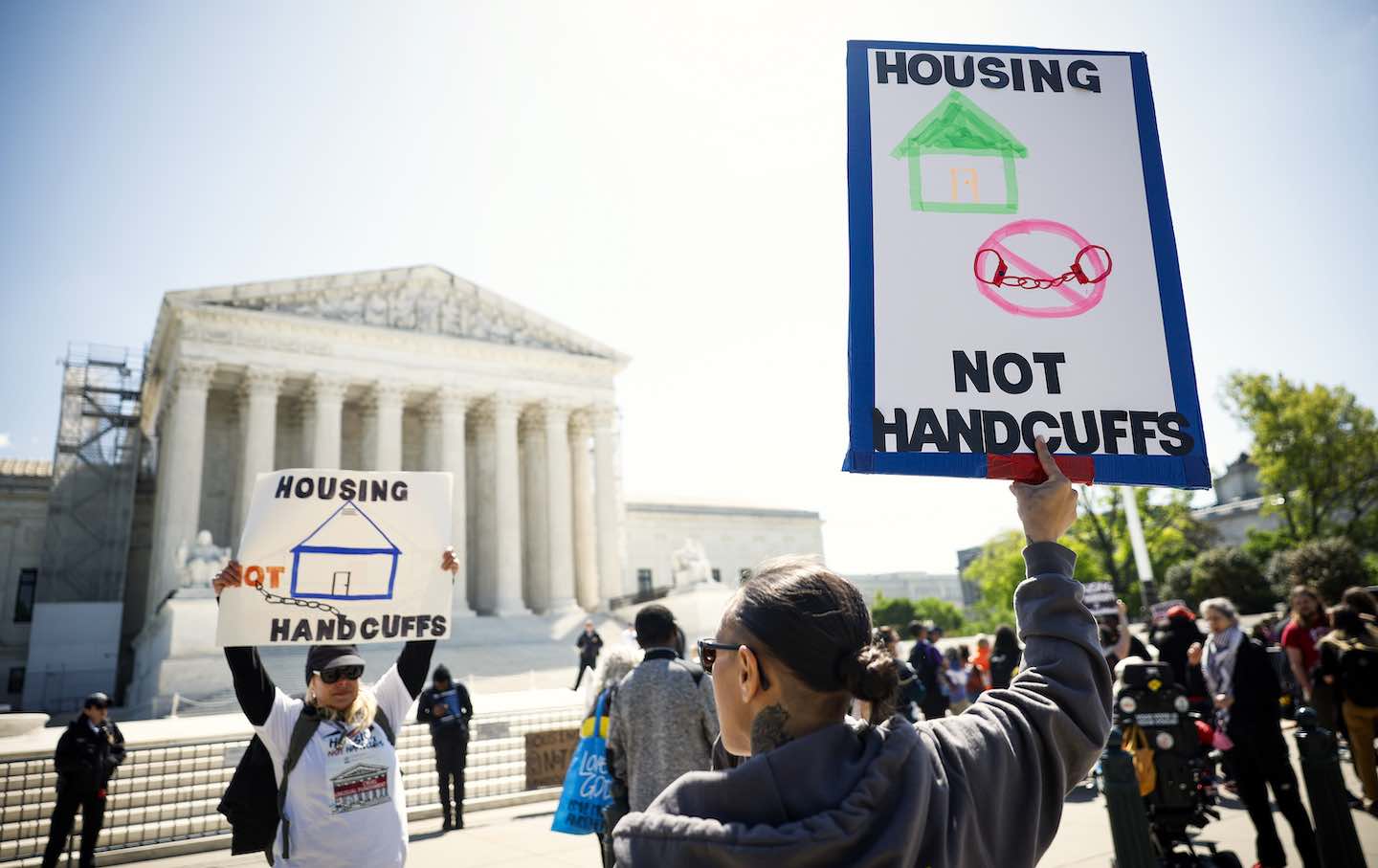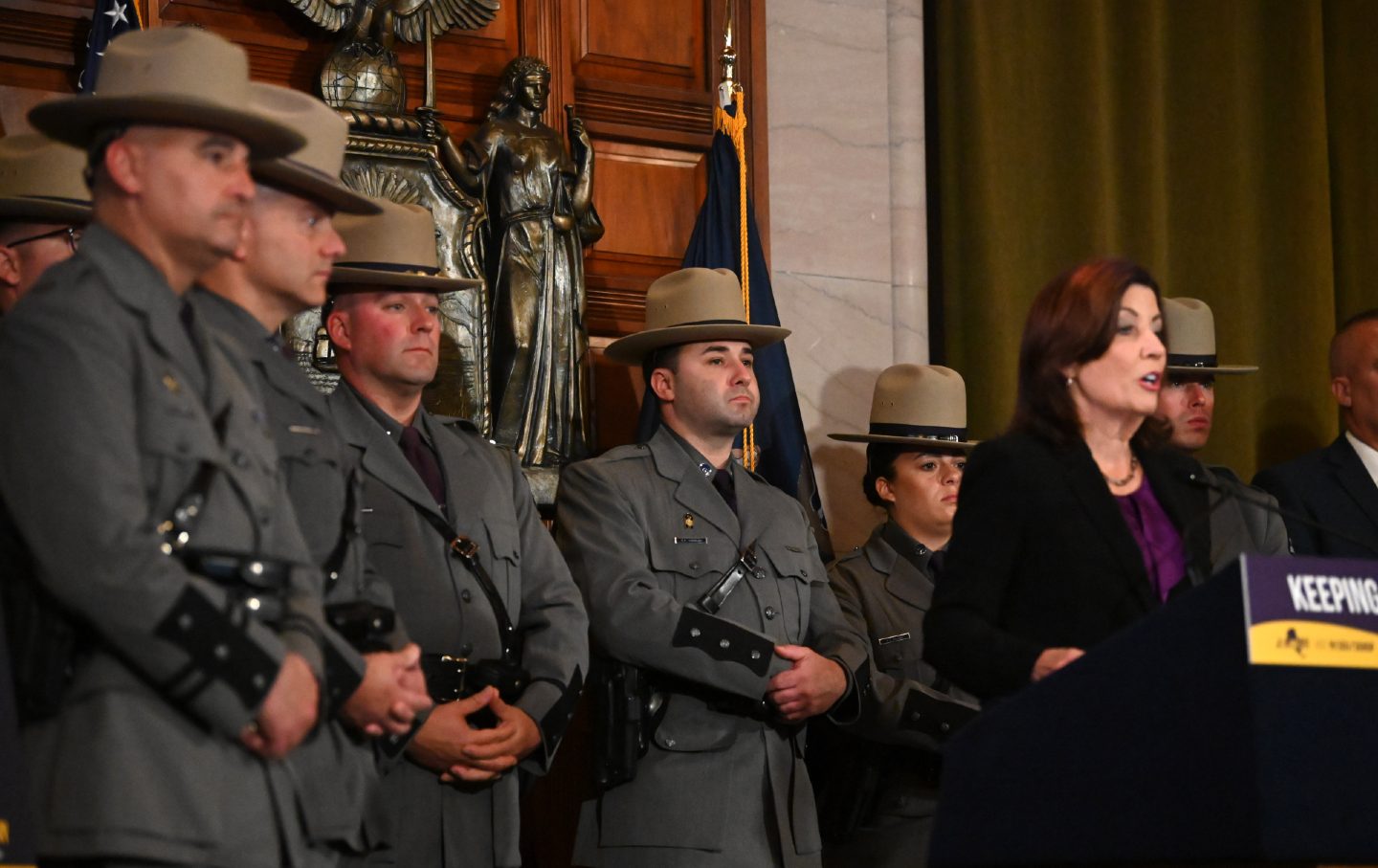One of the Supreme Court’s Most Infamous Cases Is As Relevant as Ever
Eighty years ago, Korematsu v. United States upheld the incarceration of Japanese Americans. The racism and hysteria that fueled that decision are still with us today.

Fred Korematsu in 1983.
(Gary Fong / San Francisco Chronicle via Getty Images)On December 18, 1944, the Supreme Court issued one of its most notorious decisions: Korematsu v. United States. The plaintiff, Fred Korematsu, a 25-year-old Japanese American man from San Leandro, California, who had refused orders to move to a concentration camp, was convicted of violating Order 9066, which authorized the mass removal of Japanese Americans, and Public Law 503, which sentenced any Japanese Americans who violated the exclusion order to jail.
Korematsu’s case, along with that of a young Japanese American woman and former California state employee, Mitsuye Endo, challenged the fundamental question of whether the government acted within reason when it imprisoned a whole community based on their ethnic background and outlawed their presence on the West Coast. The judges ruled 6–3 in Korematsu that the Roosevelt administration was justified in ordering the removal policy even if the kind of racial classification that implied should be subject to “strict scrutiny,” a term that endures in the court’s constitutional doctrine. The court then ruled unanimously in Endo’s case that the confinement of citizens who were “concededly loyal” to the United States needed to end.
Ironically, the Endo case had a more immediate impact in addressing the mass incarceration of American citizens. As Greg Robinson notes in his article on Ex Parte Endo for Densho, it was the Endo ruling that led the Army to lift exclusion and allow Japanese Americans to return to their homes on the West Coast after three years behind barbed wire. Yet it is Korematsu and his case that we remember most.
The Korematsu case is now seen as one of the lowest points in the court’s history, and Korematsu has been immortalized as a victim of racist American injustice. In Trump vs. Hawaii, Chief Justice John Roberts and other conservative judges specifically disclaimed Korematsu—while upholding Donald Trump’s Muslim ban.
After eighty years, the ghosts of the incarceration remain with us. Roberts did not explicitly overrule two other “Japanese internment” cases—Hirabayashi and Yasui v. US—and they remain citable as “good law.”
And even though our society has changed dramatically over the past 80 years, in many ways we are not much different from Americans in 1942. In a presidential race where the winning candidate repeated xenophobic lies about Haitian Americans, promised to deport millions of immigrants, and continued to refer to “enemies within,” we need to study this tragic chapter if we want to live in a society that values equality and rejects bigotry as a political tool.
The story of Japanese American incarceration has become a sort of Rorschach test. To liberals, it’s a painful example of racial intolerance and xenophobia. To conservatives, it’s a story of big government run amok. Perhaps among the most ridiculous and disturbing use of this history is Trump’s recent comparison between the January 6 insurrectionists and incarcerated Japanese Americans.
That nonsensical statement is easy to dismiss. But more profound corruptions of the past are also taking place, such as the recent reports that the chief archivist at the National Archives was actively suppressing information concerning Japanese American incarceration in an attempt to whitewash the nation’s history.
All Americans should be familiar with the facts. None of the 120,000 Japanese Americans who were incarcerated were found guilty of any acts of sabotage. They were imprisoned only on the grounds of their race. In fact, in November 1941, even before Pearl Harbor, a secret report commissioned by President Roosevelt, based partly on information gathered by the Office of Naval Intelligence and FBI, asserted that the overwhelming majority of Japanese Americans were loyal to the US. “We do not want to throw a lot of American citizens into a concentration camp of course, and especially as the almost unanimous verdict is that in case of war [Japanese Americans] will be quiet, very quiet.” By February 1942, however, members of Congress and the War Department lobbied Roosevelt enough to set aside the rights of a whole community.
The incarceration greatly benefited political elites on the West Coast, who scored political points with anti-Japanese exclusionists and large farming magnates who saw Japanese American farmers as competition. In his dissent in Korematsu v. United States, Ninth Circuit Court Judge William Denman slammed the unjust policy: “Along with him [Korematsu] are 70,000 American citizens men, women and children who, under similar orders, have been torn from their homes, farms and places of business to be imprisoned together in large groups, first in barbed wire stockades called Assembly Centers, then, after deportation, in distant places under military guard.”
The incarceration is, at its core, a story of how racial prejudice undermined the principle of equal protection under the Constitution. Unfortunately, many of the forces that led to incarceration in 1942 are being repeated today.
One of those forces is the media. In the months after Pearl Harbor, media outlets like the Hearst newspapers or the Los Angeles Times peddled false stories of Japanese Americans conspiring to sabotage the American war effort. The media played up fake news about middle-aged farmers spying for the Japanese government. The Times infamously claimed that all farms in the county owned by Japanese Americans were strategically placed near airports and military installations to coordinate sabotage—ignoring the fact that the farms were often built before the airports.
Prominent syndicated columnists like Walter Lippmann and Westbrook Pegler told their readers that expelling Japanese Americans from their West Coast homes was both reasonable and necessary. Just a week before Roosevelt signed Executive Order 9066, Lippman wrote that the Japanese had agents on the Pacific Coast—there were none, in fact—and that even a lack of sabotage indicated that “the blow is well organized and that it is held back until it can be struck with maximum effect.” Days later, Pegler, who applauded Lippmann’s article, wrote, “The Japanese in California should be under armed guard to the last man and woman right now and to hell with habeas corpus until the danger is over.” Both articles were circulated among members of Congress and the president as a sign that forced removal was the answer.
Some voices, however, dissented. The Nation’s own Carey McWilliams righteously defended the rights of Japanese Americans during the war and released his own book, Prejudice, that condemned the West Coast anti-Japanese movement. The Nation’s reaction to the Supreme Court’s ruling in Korematsu vs. US was similarly firm: “We fear that these Japanese cases are the thin edge of the wedge by which racial discrimination makes its first unmistakable appearance in American constitutional law.”
The newspaper era of the 1940s seems vastly different from our social media age, but we have our own fake news merchants today. As Slate reported in the run-up to the election, about half of the top-charting podcast shows on Spotify were hosted by figures aligned with the MAGA movement like Tucker Carlson and Candace Owens, who frequently spread conspiracy theories. And leading right-wing media outlets have cheered on Trump’s racist threats of mass deportations, based in part on hyped-up, misleading reporting.
The wartime events also show how political leaders can capitalize on the fears of their constituents to score political points. Members of Congress and state officials alike in California demonized Japanese Americans to boost their careers—then–Attorney General Earl Warren was elected governor in part by building on fears of Japanese Americans. When Congress interviewed Warren for his thoughts on the loyalty of Japanese Americans in February 1942, he responded: “We believe that when we are dealing with the Caucasian race we have methods that will test the loyalty of them…but when we deal with the Japanese we are in an entirely different field and we cannot form any opinion that we believe to be sound.”
Popular
“swipe left below to view more authors”Swipe →Months later, Warren campaigned as governor on the promise to protect California from “fifth column activity.” (He would later become the chief justice of the Supreme Court.)
Los Angeles Mayor Fletcher Bowron, who maintained friendly relations with Japanese Americans before the war, quickly denounced the community to maintain power. One attorney representing the Native Sons of the Golden West even filed suits to strip Japanese Americans of US citizenship and prevent them from voting in elections. In the end, it was easier for the political elites to pander to their bases than to defend a vulnerable minority.
We are no more immune to this kind of prejudice now. When I told a millennial friend several years ago that I write about the incarceration of Japanese Americans, they responded, “Hasn’t enough been written about that?” Unfortunately, as the current election has shown, the answer is no.
At an election rally this fall in Aurora, Colorado, Trump promised to use the Alien Enemies Act of 1798, which was used to incarcerate Japanese noncitizens—many of whom were elderly and barred from obtaining US citizenship by restrictive immigration laws—to enforce his deportation scheme. As with Trump’s invocation of the incarceration as a precedent for his infamous Muslim ban, his proposal offers a distorted view of history. But if we are not vigilant, we could see history repeat itself.
In the years leading up to and following the overturning of his wartime conviction in 1983, Korematsu rose to prominence as a civil rights activist and garnered celebrity status as a hero who courageously fought against incarceration. When Lorraine Bannai, an attorney on Korematsu’s legal team, asked Korematsu how he felt being a public figure, he said: “I feel that a wrong has righted, and that I’m involved. To have this, you know, not happen again, for educational purposes, I just continue on. And if I can make an appearance in class in so forth, and let the students know what happened, so this won’t ever happen to them or others, it’s worthwhile doing.”
Remembering the lessons of the incarceration is what we should be doing today, more than ever. That, I think, is what Fred Korematsu would have wanted.
Hold the powerful to account by supporting The Nation
The chaos and cruelty of the Trump administration reaches new lows each week.
Trump’s catastrophic “Liberation Day” has wreaked havoc on the world economy and set up yet another constitutional crisis at home. Plainclothes officers continue to abduct university students off the streets. So-called “enemy aliens” are flown abroad to a mega prison against the orders of the courts. And Signalgate promises to be the first of many incompetence scandals that expose the brutal violence at the core of the American empire.
At a time when elite universities, powerful law firms, and influential media outlets are capitulating to Trump’s intimidation, The Nation is more determined than ever before to hold the powerful to account.
In just the last month, we’ve published reporting on how Trump outsources his mass deportation agenda to other countries, exposed the administration’s appeal to obscure laws to carry out its repressive agenda, and amplified the voices of brave student activists targeted by universities.
We also continue to tell the stories of those who fight back against Trump and Musk, whether on the streets in growing protest movements, in town halls across the country, or in critical state elections—like Wisconsin’s recent state Supreme Court race—that provide a model for resisting Trumpism and prove that Musk can’t buy our democracy.
This is the journalism that matters in 2025. But we can’t do this without you. As a reader-supported publication, we rely on the support of generous donors. Please, help make our essential independent journalism possible with a donation today.
In solidarity,
The Editors
The Nation








